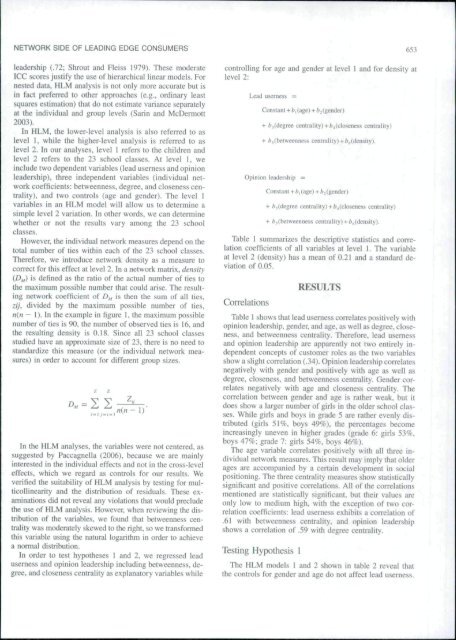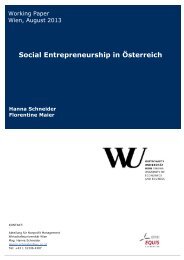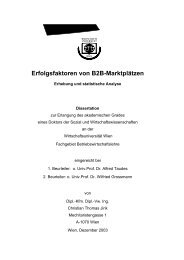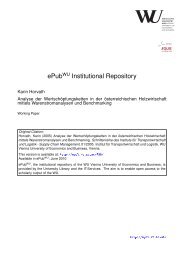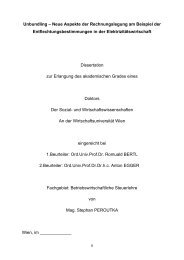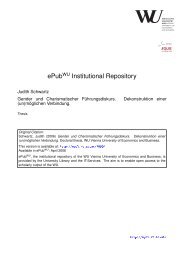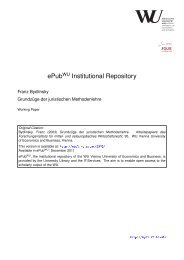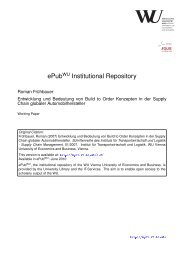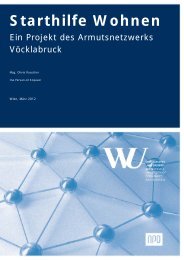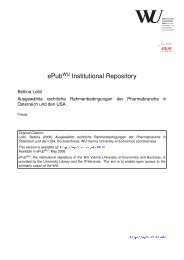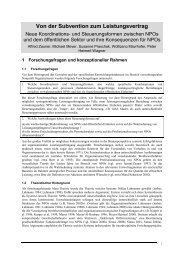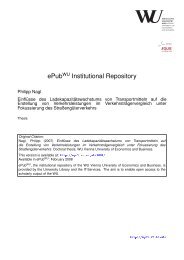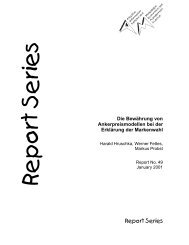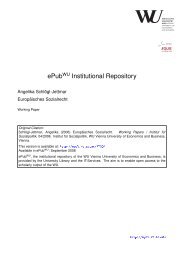Download - ePub WU
Download - ePub WU
Download - ePub WU
You also want an ePaper? Increase the reach of your titles
YUMPU automatically turns print PDFs into web optimized ePapers that Google loves.
NETWORK SIDE OF LEADING EDGE CONSUMERS 653<br />
leadership (.72; Shrout and Fleiss 1979). These moderate<br />
ICC scores justify tbe use of hierarchical linear models. For<br />
nested data, HLM analysis is not only more accurate but is<br />
in fact preferred to other approaches (e.g., ordinary least<br />
squares estimation) that do not estimate variance separately<br />
at the individual and group levels (Sarin and McDermott<br />
2003),<br />
In HLM. the lower-level analysis is also referred to as<br />
level 1, while the higher-level analysis is referred to as<br />
level 2. In our analyses, level 1 refers to the children and<br />
level 2 refers to the 23 school classes. At level 1, we<br />
include two dependent variables (lead usemess and opinion<br />
leadership), three independent variables (individual network<br />
coefficients: betweenness. degree, and closeness cenirality),<br />
and two controls (age and gender). The level 1<br />
variables in an HLM model will allow us to determine a<br />
simple level 2 variation. In other words, we can determine<br />
whether or not the results vary among the 23 school<br />
clas.ses.<br />
However, the individual network measures depend on the<br />
total number of ties within each of the 23 school classes.<br />
Therefore, we introduce network den.sity as a measure to<br />
correct for this effect at level 2. In a network matrix, density<br />
(D^) is defined as the ratio of the actual number of ties to<br />
tbe maximum possible number that could arise. The resulting<br />
network coefficient of D^ is then the sum of all ties.<br />
zij, divided by the maximum possible number of ties,<br />
n(n - I ). In the example in tigure I, the maximum possible<br />
number of ties is 90. the number of observed ties is 16, and<br />
tbe resulting density is 0.18. Since all 23 scboo! classes<br />
studied have an approximate size of 23. there is no need to<br />
standardize this measure (or the individual network measures)<br />
in order to account for different group sizes.<br />
in tbe HLM analyses, tbe variables were not centered, as<br />
suggested by Paccagnella (2006), becau.se we are mainly<br />
interested in tbe individual effects and not In the cross-level<br />
effects, which we regard as controls for our results. We<br />
verified the suitability of HLM analysis by testing for multicollinearity<br />
and the distribution of residuals. These examinations<br />
did not reveal any violations that would preclude<br />
the use of HLM analysis. However, when reviewing the distribution<br />
of the variables, we found that betweenness centrality<br />
was moderately skewed to the right, so we transformed<br />
this variable using the natural logarithm in order to achieve<br />
a normal distribution.<br />
In order to test hypotheses 1 and 2, we regressed lead<br />
usemess and opinion leadership including betweenness, degree,<br />
and closeness centrality as explanatory variables while<br />
controlling for age and gender at level I and for density at<br />
level 2:<br />
Lead userncss =<br />
Constant + h, (age) + &, (gender)<br />
+ />,(degree centrality)+ è^(closeness centrality)<br />
+ È,(betweenness cenirality)+&o(density).<br />
Opinion le^lership =<br />
Constant+è|(age)+i>j(gender)<br />
+ fej(degree cemraUty)+fcj(closeness centrality)<br />
+ /»s(betweenness centrality)+ft^(density).<br />
Table I summarizes tbe descriptive statistics and correlation<br />
coefficients of all variables at level I. The variable<br />
at level 2 (density) has a mean of 0.21 and a standard deviation<br />
of 0.05.<br />
Correlations<br />
RESULTS<br />
Table 1 shows tbat lead userness correlates positively with<br />
opinion leadership, gender, and age. as well as degree, closeness,<br />
and betweenness centrality. Therefore, lead userness<br />
and opinion leadership are apparently not two entirely independent<br />
concepts of customer roles as the two variables<br />
show a slight correlation (.34). Opinion leadership correlates<br />
negatively with gender and positively with age as well as<br />
degree, closeness, and betweenness centrality. Gender correlates<br />
negatively witb age and closeness centrality. The<br />
correlation between gender and age is rather weak, but it<br />
does show a larger number of girls in the older school classes.<br />
While girls and boys in grade 5 are rather evenly distributed<br />
(girls 51%. boys 49%), tbe percentages become<br />
increasingly uneven in higher grades (grade 6: girls 53%,<br />
boys 47%: grade 7: girls 54%, boys 46%),<br />
Tbe age variable correlates positively witb all three individual<br />
network measures. This result may imply that older<br />
ages are accompanied by a cenain development in social<br />
positioning. The three centrality measures show statistically<br />
significant and positive correlations. All of the correlations<br />
mentioned are statistically significant, but their values are<br />
only low to medium high, with the exception of two correlation<br />
coefficients: lead userness exhibits a correlation of<br />
.61 with betweenness centrality, and opinion leadership<br />
shows a correlation of .59 with degree centrality.<br />
Testing Hypothesis 1<br />
The HLM models I and 2 shown in table 2 reveal that<br />
the controls for gender and age do not affect lead usemess.


